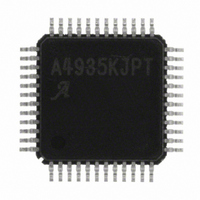A4935KJPTR-T Allegro Microsystems Inc, A4935KJPTR-T Datasheet - Page 14

A4935KJPTR-T
Manufacturer Part Number
A4935KJPTR-T
Description
AUTO THREE-PHASE MOSFET PREDRIVER
Manufacturer
Allegro Microsystems Inc
Datasheet
1.A4935KJPTR-T.pdf
(24 pages)
Specifications of A4935KJPTR-T
Configuration
3 Phase Bridge
Input Type
PWM
Delay Time
90ns
Number Of Configurations
1
Number Of Outputs
3
Voltage - Supply
5.5 V ~ 50 V
Operating Temperature
-40°C ~ 150°C
Mounting Type
Surface Mount
Package / Case
48-LFQFP Exposed Pad
Operating Temperature Classification
Automotive
Operating Supply Voltage (min)
3V
Operating Supply Voltage (max)
5.5V
Lead Free Status / RoHS Status
Lead free / RoHS Compliant
Current - Peak
-
High Side Voltage - Max (bootstrap)
-
Lead Free Status / Rohs Status
Compliant
Other names
620-1300-2
A4935KJPTR-T
A4935KJPTR-T
Available stocks
Company
Part Number
Manufacturer
Quantity
Price
Company:
Part Number:
A4935KJPTR-T
Manufacturer:
Allegro Microsystems Inc
Quantity:
135
Company:
Part Number:
A4935KJPTR-T
Manufacturer:
Allegro MicroSystems, LLC
Quantity:
10 000
Part Number:
A4935KJPTR-T
Manufacturer:
ALLEGRO/雅丽高
Quantity:
20 000
A4935
Fault Register
All undervoltage and short faults are recorded in a 10-bit fault
register as defined in table 3. The fault register accumulates all
detected faults until cleared by setting RESET low, by cycling the
power off and on, or by reading the contents. The contents will
also be cleared if a VDD undervoltage fault is detected. During a
VDD undervoltage fault condition, both fault flags will be high
but all the bits in the fault register will be reset.
Table 3. Fault Register Bit Definitions
The contents of the fault register can be read serially from the
FF1 pin by applying a clock signal to the FF2 pin during an
undervoltage or short fault state.
The fault flag pins, FF1 and FF2, are open drain outputs and pas-
sively pulled high when a fault is present. This makes it possible
to drive one or both of these fault pins from an external source
during a fault condition, when the A4935 is not pulling the pin
low. FF2 can thus be used as a clock input to shift out the fault
status register, bit-by-bit, on the other fault flag, FF1.
When FF2 is being pulled low by the A4935, either when no fault
is present or when an overtemperature fault is present, then no
serial access is possible. The fault status register can be accessed
only when FF2 goes high. This occurs when either a short or an
undervoltage fault has been detected.
Faut Register Serial Access
To access the fault register, FF1 and FF2 must be monitored by
an external controller. If FF2 goes high and FF1 remains low,
then a short has been detected. If FF1 and FF2 go high together,
AH
BH
CH
VR
VC
Bit
CL
VB
AL
BL
VA
Position
First
Last
2
3
4
5
6
7
8
9
V
V
V
V
V
V
Undervoltage detected on VREG
Bootstrap undervoltage detected on phase A
Bootstrap undervoltage detected on phase B
Bootstrap undervoltage detected on phase C
DS
DS
DS
DS
DS
DS
exceeded on A phase high-side FET
exceeded on B phase high-side FET
exceeded on C phase high-side FET
exceeded on A phase low-side FET
exceeded on B phase low-side FET
exceeded on C phase low-side FET
Function
Automotive 3-Phase MOSFET Driver
then an under voltage has been detected. In either case, the
sequence for reading the contents of the fault register is:
1. The external controller takes any necessary additional action to
2. The external controller pulls FF2 low.
3. The A4935 outputs on FF1 the fault register first bit, AH.
4. The external controller reads the fault bit, and then cycles FF2
5. Steps 3 and 4 alternate until all of the 10 bits in the fault regis-
6. After the final bit, VC, is output, the external controller cycles
7. The A4935 resets the fault register and pulls FF1 and FF2 low
8. The external controller releases FF2.
The basic sequence for the three possible states of FF1 and FF2
are shown in figure 1.
At the end of the serial transfer, on the last high-to-low transition
input to FF2, the fault register and the fault flags are reset. How-
ever, it is possible that one of the three unlatched fault conditions,
VREG undervoltage, VDD undervoltage, or overtemperature, is
still present. In this case the fault flags will immediately show the
fault status.
Resetting the VR Bit
At power-up, on coming out of reset, or after a VDD or VREG
undervoltage fault, it is possible that the fault flags and fault reg-
ister will have cleared but the VR bit in the fault register remains
set. This would happen if, when a power-on-reset occurred,
V
V
and the fault flags are cleared when the fault is removed, the
VR bit in the fault register is latched and may remain set after
the power-on-reset. For this reason it is recommended, when the
serial fault register is to be used, to perform a reset by taking the
RESET pin low for less than the reset pulse time, t
A4935 is powered-up and all fault flags are clear (FF1 and FF2
are low).
REGUVon
REG
protect the FETs.
high then low for the next bit, BH.
ter have been read out.
FF2 high then low.
to indicate no fault present.
had not yet risen beyond the undervoltage threshold level,
. Although VREG undervoltage fault state is not latched
115 Northeast Cutoff
1.508.853.5000; www.allegromicro.com
Allegro MicroSystems, Inc.
Worcester, Massachusetts 01615-0036 U.S.A.
RES
, after the
14
















